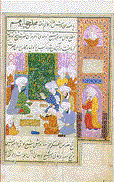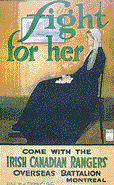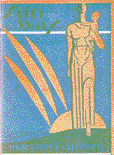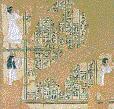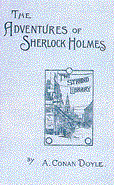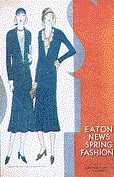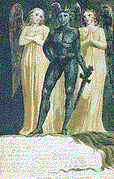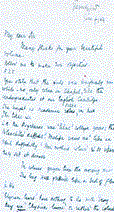 |
 | ||
 | |||
 | |||
 | |||
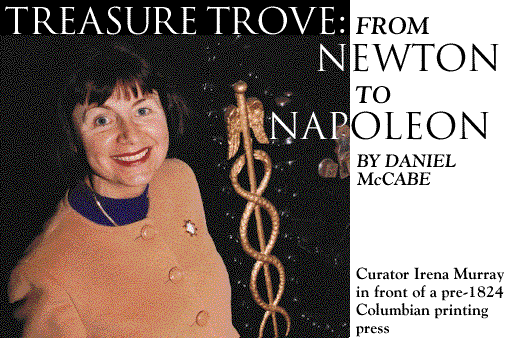
| |||
|
Allegorical depiction of Napoleon as a triumphant Roman emperor drawn and engraved by Louis-François Mariage of Paris.
Page from a 16th century Persian manuscript. This miniature is called "A Gathering of Poets."
Print bought at a local auction for $7 showing the ice castle built for Montreal's 1887 Winter Carnival.
Portrait of John Ker, 3rd Duke of Roxburghe (1740-1804).
Punch, from a set of glove puppets, English, ca. 1850.
First World War poster designed by Montreal artist Hal Ross Perrigard, based on Whistler's famous painting of his mother.
View of Montreal ca. 1842 by artist John Coke Smyth, drawing master to Canadian Governor-General Lord Durham, from his work "Sketches in the Canadas."
Art Deco book cover.
Rare volume of the Jesuit Relations, 1638. These regular reports sent back to Europe by priests described their progress in converting native people to Christianity, and contain much historical information on life in New France.
Draft manuscript of "Queen Mab" by Percy Bysshe Shelley, with the poet's annotations.
Piece of Egyptian papyrus, probably a fragment from a Book of the Dead. The books were placed in tombs and graves to serve as "passports" to the afterlife.
First edition of the famous detective novel published in London in 1892.
This tiny wooden pagoda contained the scroll shown behind it. Dating from 770 AD, the scroll is the earliest known example of printing from wood blocks, and is one of an edition of a million copies of Chinese Buddhist texts ordered by Japanese Empress Shotoku for distribution in Japan.
Eaton's Catalogue cover, Spring of 1930.
Map of North America by Dutch cartographer Hon-dius ca. 1639. Much of the continent remained to be explored, evident from the fact that several of the Great Lakes are missing as is the Mississippi River, and California appears as an island. From the collection donated by Professor William Pugsley in 1971.
Illustration by poet and artist William Blake from a facsimile of Europe, a Prophecy, originally published in 1794. The facsimile edition was published in London by Trianon Press in 1969.
Letter from Alfred, Lord Tennyson, to the Montreal publisher Samuel Dawson dated 1894. One of a vast holding of "autograph" letters, the division of Rare Books and Special Collections is often asked to contribute to editions of correspondence to and from famous people.
Early editions of children's books. |
A major move is on the list of life's traumatic experiences. So is the arrival of a new boss -- especially one with a lot of ideas for change. So it was not surprising that when Irena Murray, MArch'91, became the head of the Rare Books and Special Collections Division of McGill's Lib-raries in 1996, the staff was a little wary of the architecture buff with the intense blue eyes. Murray soon made it clear that she thought the division should have both a new home and a new attitude. The focus had always been on preserving the collections -- many items of which are centuries-old and rather fragile. For her part, Murray wanted to throw open the doors. "Nobody wants to preside over a dead collection. When I first started, I would look around me and think of that line from Casablanca, 'Round up the usual suspects.' I wanted to see some new faces in here." Making that possible has required consolidating the collections and moving everything to a more suitable location. Situated in the dim and sombre bowels of the McLennan Library, the division's damp quarters were far from an ideal home -- 235 precious books were damaged during a 1995 flood. Marshalling her considerable lobbying skills, Murray secured new space for the division. The move, which in the end played a pivotal role in the new director winning over her staff, took place last summer. Asking them to handle much of the planning for the move, Murray also gave her staff a lot of responsibility for figuring out where everything should go. "They were wonderful, and the experience really brought us together. That was when we started to feel like a team," says Murray, who also convinced her co-workers that increased accessibility and a dedication to preservation didn't have to be mutually exclusive. Reopened last fall, Rare Books and Special Collections now enjoys bright and airy quarters on the library's fourth floor. The enlarged reading room is more closely linked to the division's holdings, which were previously located on a separate floor. Now a visitor need only take a short stroll -- in the company of a curator -- to have a look at some of the division's most exceptional holdings. Students zipping up the stairs in the McLennan Library are likely to pause once they reach the fourth floor. On the landing behind a glass wall is a stunning Columbian printing press (Columbian refers to a particular size of type) which stands as an inducement to come inside and visit the division's other treasures. And what treasures! The division's collections are among the most impressive and eclectic in the country. Together with McGill's Osler Library of Medical History, the division boasts the largest collection of incunabula -- books published before 1501 -- in Canada. A remarkable collection of 171 hand-crafted puppets from Europe, Asia and the Americas attracts puppet enthusiasts from around the world. Other gems include letters composed by influential 18th century philosopher David Hume, correspondence from many of that century's leading Canadian fur merchants (including our own James McGill), Napoleonic prints depicting the French leader's exploits, a 1,700-volume cookbook collection, a wide selection of cowboy fiction, some of the first maps created of Canadian territory, initial drafts of Stephen Leacock's fiction and a tiny wooden pagoda from 770 AD containing one of the earliest examples of Chinese printing in the world. "I wanted the new location to mark a fresh start for us," says Murray. And so it has. A sparsely attended poetry reading series was spruced up by Murray and her staff, who moved the evening event to the lunch-hour, supplied sandwiches and did a little advertising. "Now it's standing room only," says Murray of the series, which helps showcase the division's extensive holdings of Canadian poetry. Other events were carefully orchestrated to shed images of must and dust and to make the collections come alive for new audiences. The recent publication of a book about the division's Joe Fishstein collection of Yiddish poetry, edited by Jewish Studies bibliographer Goldie Sigal, led to a series of lectures and an exhibition detailing how Fishstein, a modestly educated New York City garment worker, slowly assembled his own dazzling library of Yiddish works. Top scholars of Yiddish literature as well as residents visiting from a local seniors' home lapped up the tale. Another recent exhibition focused on the Palmer Cox collection. The Quebec-born children's author wrote and illustrated the adventures of the Brownies, fairies who finished household and farm chores while families slept. The pint-sized characters were wildly popular and became a marketing sensation in the 1920s and '30s, appearing in ads for everything from ice cream, maple syrup and soft drinks to carpeting, coffee and "sick stomach" remedies. Kodak's Brownie camera was named for them. The collection features original artwork by Cox, and the exhibition attracted first-time visitors from the artist's native Eastern Townships. "Each event brings new people who've never been here before. It has a domino effect," says Murray. A library that makes itself useful to the community will be sustained by the community in turn, she believes. "With the Fishstein talks, we had people coming up to us later, talking about their own collections of Yiddish literature. There might always be another Mr. Fishstein out there." But Murray says collectors of rare books and artifacts can be difficult to cultivate. "You can't really go 'fishing' for them because you often don't know who they are. Who could have guessed that Mr. Fishstein would have amassed such an amazing collection? A management professor, the late William Pugsley (BCom'34), ended up giving us a collection of precious maps dating back to the discovery of Canada. It turns out he was an officer in the Canadian navy with a passion for maps, but none of us would have thought of him as a collector. "Donors are a special breed," adds Murray. "Their decision to give their collections to one institution instead of another is predicated on their own intuition as to who would give their treasure a good home. They want someone who can take proper care of their donations and make them useful. No one wants their donation to be locked away in a corner and forgotten. I've seen this played out over and over again." She speaks from experience. Before taking on her current job, Murray headed McGill's Blackader-Lauterman Library of Architecture and Art. While there, she found herself competing with Harvard University for a precious collection -- famed architect Moshe Safdie was looking for a home for his ar-chives. Safdie, BArch'61, LLD'82, the mastermind behind Montreal's Habitat, a modular housing complex built for Expo '67, the Montreal Museum of Fine Arts extension, the National Gallery in Ottawa, and the Vancouver Public Library, opted for his alma mater. Certainly, loyalty played a role in his decision, but he was impressed by the special care Murray and her staff gave to the collections in Blackader-Lauterman. Safdie was also persuaded by Murray that his archives would receive greater attention at McGill -- Harvard already had so much of everything, there was a greater danger of items, even remarkable items, getting lost in the shuffle. Murray was true to her promise. She edited a much-praised and award-winning book about the Safdie archives and is busy preparing an exhibition on McGill's Safdie collection, slated to begin in 2001, for the Montreal Museum of Fine Arts. "It's never one factor alone," Murray says of donors' decisions. "It's always more complex than that." Rare Books and Special Collections is open to anyone, Murray stresses. "Nobody needs an appointment. We're open from nine to five. You just walk in and tell us what you want to see." Murray and her staff might be welcoming, but not careless. You're cordially invited to check out the division's holdings, to be sure, but you have to abide by the rules of the place. Most personal belongings have to be parked a fair distance away from any books or prints. Pens and markers are verboten -- if you want to jot down some information, you'll have to use a pencil supplied by the division. Laptops are fine, but you need permission to make photocopies. And don't even think about bringing food in. Murray's team is employing decidedly modern means to further promote the accessibility of the irreplaceable materials in their collections -- they're turning to the web. Murray and digital collections librarian David McKnight head a project whereby many of the McGill Libraries' unique texts and prints will be scanned and placed on a website. One of the first items to be digitized is a collection of author and McGill professor Hugh MacLennan's letters, which supply arresting insights into what made the beloved writer of Barometer Rising and Two Solitudes tick. The website will also eventually include two unpublished novels by MacLennan, making them available to the public for the first time. "That's a bit of a coup for us," relates McKnight. Murray is proud of what has been achieved so far and has high praise for the support and expertise provided by her staff. But there's no time for resting on any laurels, as the division's collections continue to grow. McGill recently received the complete archives of Tundra Books, founded by May Cutler, BA'45, MA'51, for many years considered the best children's book publisher in Canada. The Canadian Olympic Association, which recently closed its documentation centre, donated its archival material on the history of the modern Olympics. The material includes some historically fascinating documents connected to Berlin's 1936 Olympics, when Nazi Germany went on an all-out propaganda offensive. "The number of phone calls we've been receiving about this collection is nothing short of phenomenal," says Murray. "I think this place is one of the greatest public relations departments a university can have," she adds. "It's one thing to tell people that our libraries have over 5 million items -- that's an abstract notion. When we tell people that we have a first edition of a book by Isaac Newton that includes his hand-written annotations in the margins, that makes the magic of what we have here come alive." Can't visit in person? Tour the holdings in Rare Books and Special Collections on the web at www.library.mcgill.ca/rarebook/cube.htm. | ||

